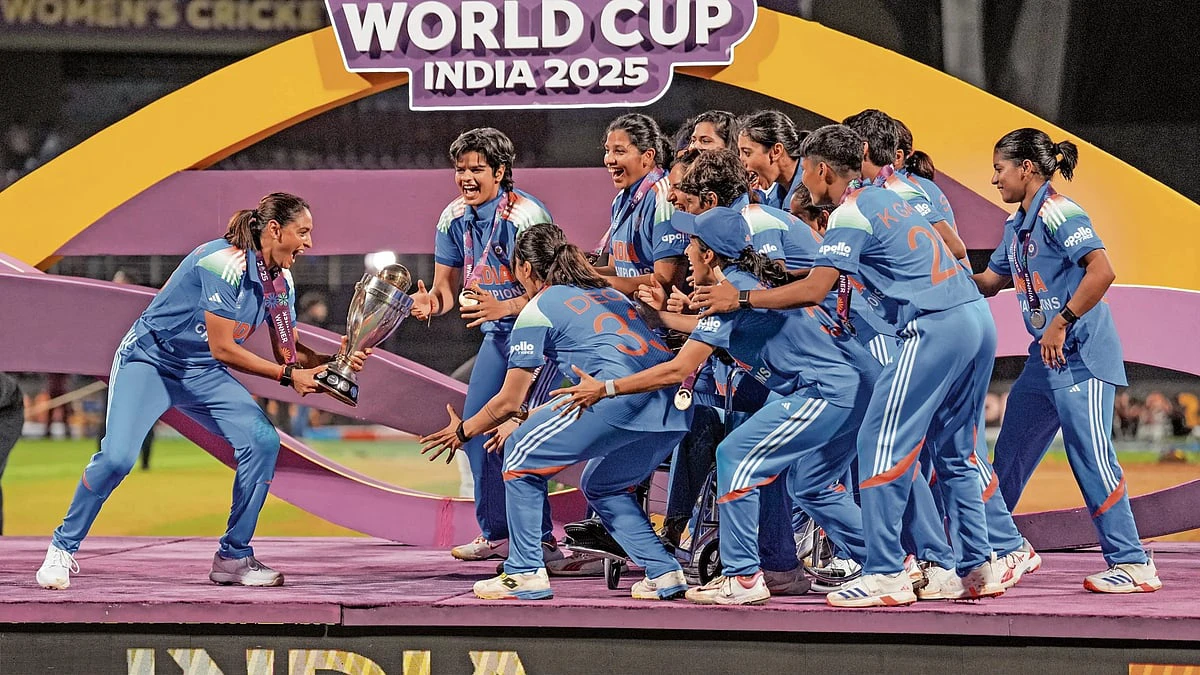As India celebrates victory at the Women’s ODI World Cup and swoons over the up-until-now ignored team of dazzling sportswomen, I observe how women rejoice when they win.
Asked about her fantastic performance in the semi-finals against Australia, Jemimah Rodrigues thanked each person by name from the team who supported her through her anxious state during the tournament and in the match leading up to her century. After receiving the trophy, Captain Harmanpreet Kaur invited seniors Jhulan Goswami, Anjum Chopra and Mithali Raj – who had come very close to winning it in 2005 and 2017 – to share the honour of holding it up. Among videos of jubilant dancing that filled social media, I found our team embracing with great affection their opponents, those they beat, the players from South Africa. In all their actions I witness them in their triumph remembering, acknowledging and making space for other women – their team mates, their predecessors, and even their adversaries.
This taking a step back from the focus of the glory and pulling others into light is rare.
What kind of relationships do women form with other women when they work, play, and create together to make this possible? It benefits patriarchy to have us believe that women are women’s worst enemies. This is a recruitment strategy for foot soldiers! Manipulating some women by bestowing scraps of power to use for their own benefit and control of others; or compelling them to compete for paltry resources like the attention of men or a seat at their table inculcate narratives that support this theory. The contentious saas-bahu relationship is caricatured into serials running for decades, invisibilising the deep generational trauma women endure at the heart of the complex institution of marriage. It also erases stories of kinship between women that are often vital for their very survival in families steeped in deeply casteist, patriarchal and heteronormative injustices. Enough is whispered of grandmothers financing the flight of girls to study and work; aunts enabling inter-caste, inter-faith marriages; and daughters-in-law caring for abandoned mother-in-laws when sons escape to more convenient wives and lives. But these are overlooked, lest women discover how radically threatening our connections can be for patriarchy.
Forging female friendships
Ma told me of the practice of ‘shoi patano’, a ritual of deliberate ‘forging of friendship’, which used to be common among women in Bengal in the late 19th and early 20th century. They would affectionately call each other by names of flowers, plants and everyday objects that were metaphors for their relationship. They nurtured a private world with shared laughter, coded language, and handwritten letters building unwavering trust of foremost confidantes. This intimacy created a crucial sanctuary – a safe space within a deeply misogynistic and restrictive patriarchal society. Ma shared that when one shoi got married leaving for a faraway village, the other grieved like a forlorn lover. In some cases they would continue to write to each other. Often a shoi was the sole keeper of all one’s secret desires and forbidden flights.
This visceral bond much like today’s ‘chosen family’ challenged the control of natal and marital families. It also contested the assumed hierarchy of spousal couples as the most intimate of relationships in heteronormative worlds thus queering the pitch.
I am fortunate to have experienced closely how female camaraderie draws others into luminescence. During the Anti-CAA protests that stormed the country a few years ago, while Delhi had Shaheen Bagh, Mumbai its Azad Maidan – in Bangalore we mobilised Bilal Bagh. Hundreds of women from across class and community squeezed in, under one shamiana, drawing posters, singing songs and minding each other’s children. Women who had never shouted a slogan in their lives raised fists against the politics of hate. Serendipitous camaraderie tentatively evolved into fledgling friendships.
While the pandemic halted the resistance, many of us reconnected and formed a motley gang of sisters. Declaring a certain crossroad Aman Dweepa, our island of peace, we continue to meet regularly at homes, parks and streets to work for a more inclusive society as well as stand by each other. There are no leaders or mobilisers in this group, only a practice of debate, building consensus and shared responsibilities. And since we know well the vulnerability of individual battles and monstrosity of powers that be, the splendour of every achievement is shared.
The spotlight on women is rare; the price exorbitant; the impact – uncertain. Therefore when one has it, we share. Perhaps a profound sense of marginality in the face of society’s oppression makes women pull each other into the ambit of illumination. It is recognition of shared histories of omission. These days I notice more and more women across age and class travelling, laughing, eating and hanging together, and as I marvel at the resilience of sisterhood I imagine a world where everyone stands in the sun.
